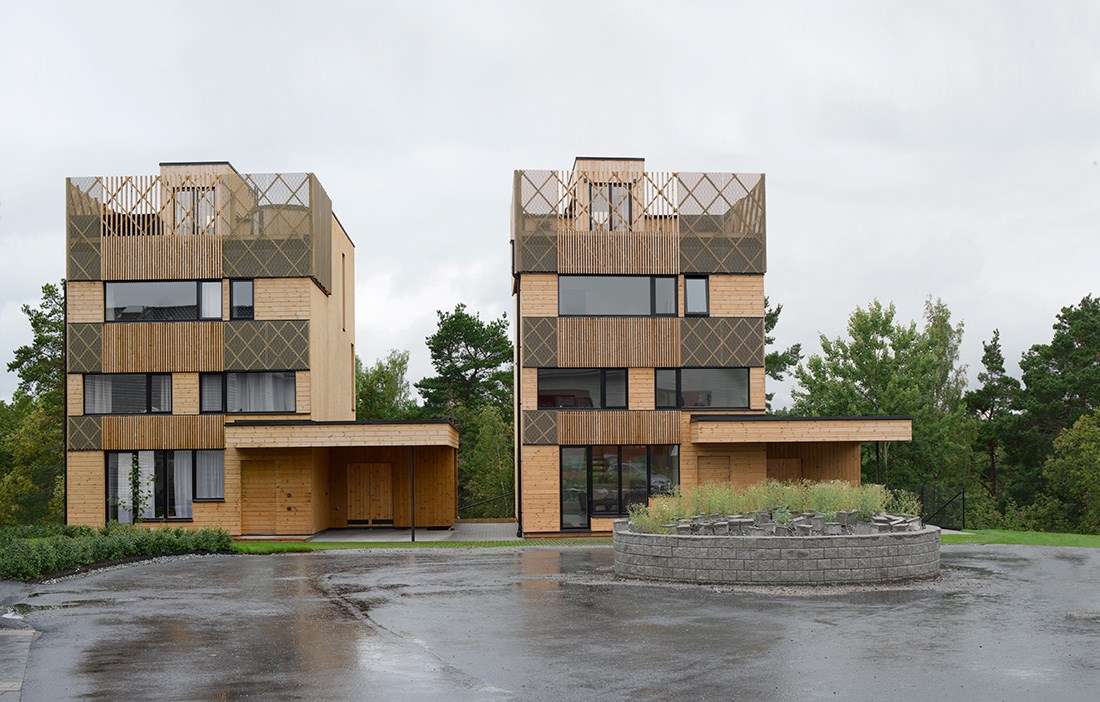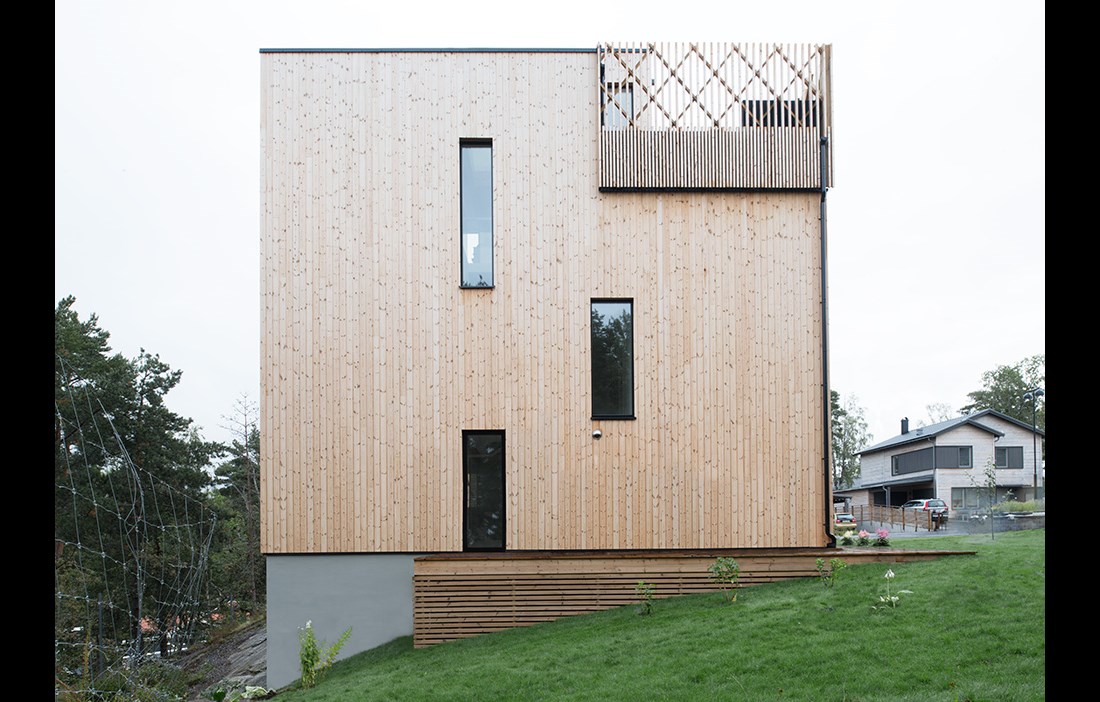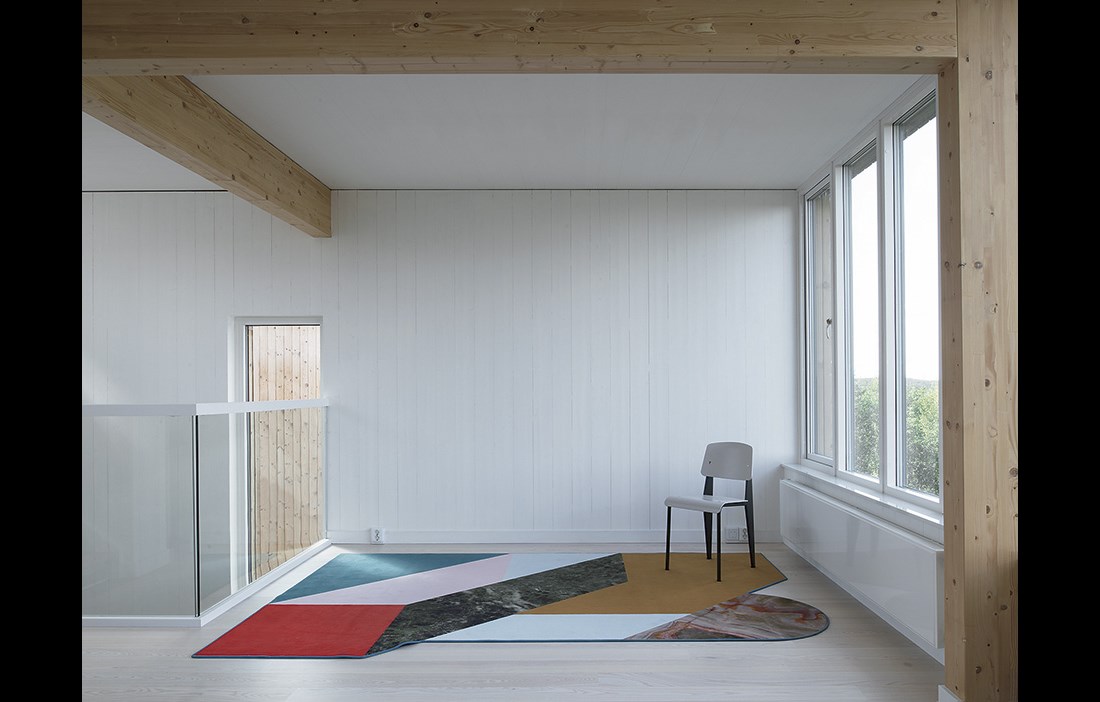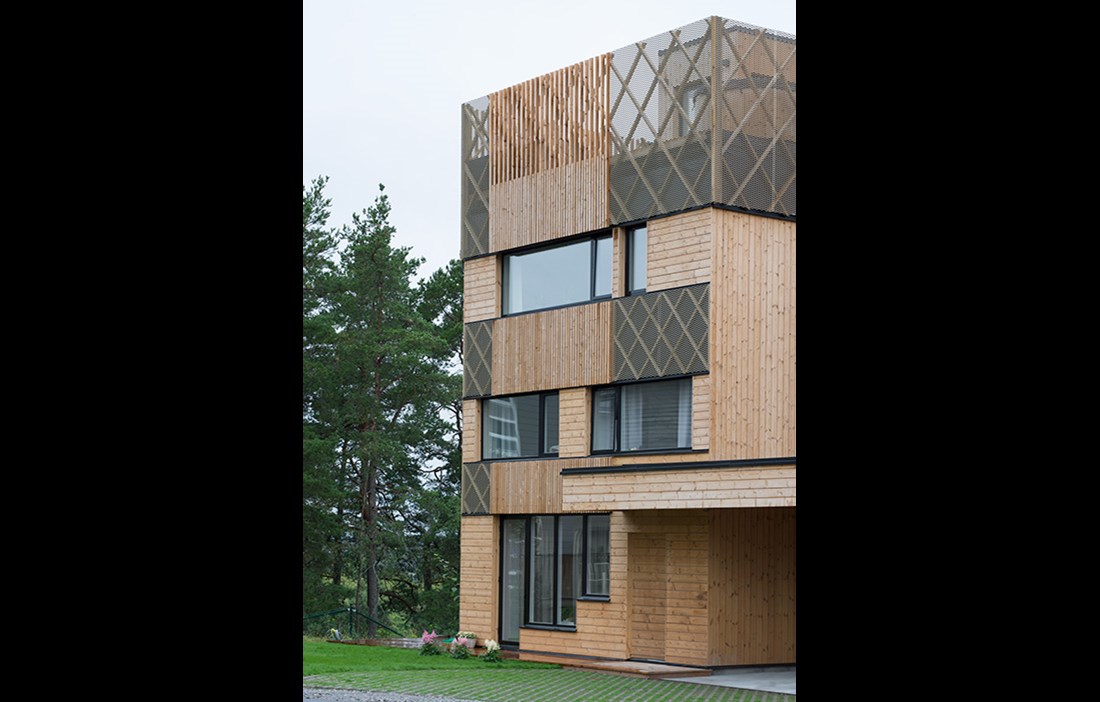A whole new residential development is emerging in Tollare, Nacka, a location close to nature and set high up, offering personal homes and panoramic views. Forest paths and the archipelago are within walking distance, as are local services. And the buzz of the capital is within easy reach.
The four phases of Propio Fastigheter’s project are at varying stages of completion, from ready to start to ready to move in. However, whether they are site-built detached, semi-detached or terraced houses over four floors, what they all have in common is a mass timber structure in CLT, with no mineral wool, plastic, plaster or composites.
“As far as I know, we’re the only ones building with 100 percent renewable wood fibre,” says Daniel Fagerberg.
He is an architect who trained in London, UK, and Newcastle, Australia, held an eight-year professorship at the University of Nebraska, USA, and has lectured extensively across most of the world on the theme of industrial wood construction.
As well as a passion for surfing, he has taken from Australia an Anglo-Saxon view of the architect’s role, where you act more as a developer than a manager of the planning process and have a key function in the whole construction process – from drawing board to building site and topping-off ceremony.
In Australia, with its pronounced climate concerns, he also developed an interest in toxin-free, ecological, low-energy and economical building.
“When you’re training there, everything is about the environment, from the first pen stroke to the first building,” he explains.
Using CLT panels is a construction principle that has stayed with him since his early years in the industry. As well as having environmental benefits, they are also easy to work with. No complex fastenings are required – in fact the philosophy is that all you should need is wood screws.
By developing software to control the machines, Daniel Fagerberg was able to make the wood technology more accessible and so also more financially viable. This technology allowed the façade of the ABBA museum, for example, to be prefabricated much more quickly than building it on site, and at half the cost.
“I’ve been researching and working with CLT since 1998 in an attempt to get the machines to do what I want. Now we have the skills to use custom mass timber panels as a construction material in slightly larger projects,” Daniel adds.
And one repository for these skills is the team of engineers, architects and consultants that work at Strombro Building Workshop, which was founded by Daniel Fagerberg and specialises in sustainable construction techniques. They also have a close partnership with Propio Fastigheter, where Daniel’s brother Fredrik Fagerberg works.
The low-energy houses that are part of the Tollare Arkipelag project stand out with their exciting design and smart environmental profile. In addition, they are created within a network of equal parts design, fabrication and on-site construction.
Daniel Fagerberg talks about large, dimensionally stable surface units in CLT that are manufactured in Latvia. They are almost 14 metres long, with window and door openings cut to precise measurements, and they are easy to connect with wood screws, a screwdriver and taped joints for a sufficiently airtight end result.
“This technique gives us all sorts of opportunities for innovative and creative solutions. What’s more, a structure with walls and floors in mass timber is both quiet and diffusion resistant, which ensures a pleasant indoor climate.”
The building stands on an exposed concrete slab. A fan blows air down onto the heated floor, from where it then circulates to keep the rest of the house warm. As the only source of heating, this has low energy costs and removes the chance of microbial growth.
The wood is a strong visible presence everywhere, in the floors, walls and ceilings. All the panels on everything from the roof to the façades and ceilings are made in-house and the insulation is renewable wood wool. Even the bonded fabric is cellulose-based.
“The whole house can breathe, as the wooden structure both absorbs and releases moisture. This provides an indoor climate that is free from toxins, particles and dust whirling around.”
Daniel Fagerberg begins our study visit to the construction site by stopping outside what will be phase four. At the moment all you can see is a fence and a few piles of gravel. By the last quarter of next year, the intention is that 11 terraced houses, each with four floors, will be ready to move into.
“What they all have in common is a frame, floors and walls made from CLT. The façade is made up of hard wood wool insulation, which is rendered and painted white. Other features are solar panels on the roof, terraces, quality joinery in the kitchen and shared gardens,” says Daniel.
Phase two is a development of semi-detached houses built along the same lines, with a CLT carcass and a façade of white painted render. Phase three also involves houses with a CLT carcass and wood wool insulation, but with a metal façade.
Finally there is phase one, TA+1, which is made up of four three-storey detached houses, whose façades and roofs are finished with heat-treated pine cladding. Otherwise, they are built according to the same principles as the rest of the Tollare Arkipelag project: a structural frame made entirely from CLT.
“Glulam is only used where we need to strengthen our structures to handle spans of more than 5.5 metres. The floor structure, roofs and walls all use CLT,” says Daniel.
Large wooden units were delivered by trailer and fitted together with extreme precision to create the four houses that have now been completed and handed over to their new owners. The design and the exterior in silvered wood are meant to call to mind traditional barns.
With moving boxes stacked along the walls and tradesmen coming and going as they complete the final touches, the Lidholms, a young family with two children welcome us to their new home. As they explain, design and environmental thinking were crucial to them.
“A home with a cross laminated timber frame was attractive. And we weren’t disappointed, inside it’s quiet and wonderfully cosy, and the air is good for the children,” says Carl Lidholm.
Maria Lidholm agrees that an eco-friendly and sustainable building felt like a natural choice.
“Plus it looks fantastic and it’s in a wonderful location,” she adds.
We are given a guided tour of the house – from the built-in kitchen on the entrance level, finished in birch and cherry, via the bathroom and living room on the first floor to the bedrooms and terrace on the second floor. Another half staircase leads to a large, open roof terrace with never-ending views.
Wood is everywhere. Wooden floors, ceilings, walls, window frames and stairs. Even the roof is clad in wood.
Daniel Fagerberg is at least as excited as the Lidholm family about seeing all the wood.
“I don’t know of any other building material that is one hundred percent renewable. In addition, it makes it possible to build buildings that we would like to live in, without any plaster or toxins.”
Text Mats Wigardt

























